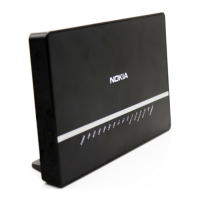Virtual Private LAN Service
174
FD 100/320Gbps NT and FX NT IHub Services Guide
3HH-11985-AAAA-TQZZA Issue: 13
5.4 VPLS feature enhancements
This section describes v-VPLS and m-VPLS supported enhancements and features.
5.4.1 Local and Remote Aging Timers
Like a Layer 2 switch, learned MACs within a VPLS instance can be aged out if no
packets are sourced from the MAC address for a specified period of time (the aging
time). In each VPLS service instance, there are independent aging timers for locally
and remotely learned MAC entries in the forwarding database (FIB). A local MAC
address is a MAC address associated with an SAP because it ingressed on an SAP.
A remote MAC address is a MAC address received via a mesh/spoke SDP from
another PE for that VPLS instance.
The local-age timer for the VPLS instance specifies the aging time for locally learned
MAC addresses and the remote-age timer specifies the aging time for remotely
learned MAC addresses.
In general, the remote-age timer is set to a longer period than the local-age timer to
reduce the amount of flooding required for destination unknown MAC addresses.
The MAC aging timers can be changed after the v-VPLS/VPLS service is configured.
MAC aging cannot be disabled to prevent any learned MAC entries from being aged
out of the FIB. Note that static FDB entries are not subject to aging and can only be
removed by the operator.
5.4.2 User to User Communication
The v-VPLS and VPLS behavior distinguishes between the user-side and
network-side, to enable the ability to control user-to-user communication.
User-to-user communication can be enabled or disabled, to allow or prevent
user-to-user communications between residential ports. Note that network ports are
created in regular mode. If the port is later assigned to a sub-tending NE, the port
can be changed to residential, and user-to-user communication can be enabled in
the v-VPLS/VPLS instance.
5.4.3 FIB Table Management
The following sections describe VPLS features related to management of the
Forwarding Information Base (FIB).

